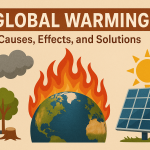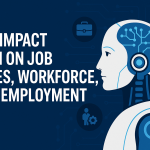The Impact of AI on Job Roles, Workforce, and Employment
In recent years, Artificial Intelligence (AI) has transformed from a futuristic concept into an integral part of our daily lives. From automating customer service with chatbots to analyzing massive data sets for decision-making, AI is reshaping industries across the globe. As this technology continues to evolve, it is significantly influencing job roles, workforce dynamics, and the overall employment landscape.
Understanding AI and Its Capabilities
Artificial Intelligence refers to computer systems designed to perform tasks that typically require human intelligence. These include problem-solving, decision-making, speech recognition, language translation, and visual perception. Machine learning, deep learning, and natural language processing are some subfields of AI that enable computers to learn from data and improve their performance over time without explicit programming.
How AI Is Changing Job Roles
AI is not just replacing tasks—it’s redefining roles altogether. In many sectors, it’s augmenting human abilities, allowing professionals to focus on high-value work while AI handles repetitive tasks. Here’s how job roles are being reshaped:
1. Automation of Repetitive Tasks
Jobs that involve repetitive and predictable tasks are most vulnerable to automation. This includes roles in data entry, basic customer support, routine manufacturing, and administrative assistance. AI-powered tools can perform these tasks faster and with fewer errors.
2. Creation of New Job Categories
Contrary to fears of widespread job losses, AI is also creating new types of jobs. Roles like AI ethicists, data scientists, machine learning engineers, and automation specialists didn’t exist a decade ago. As AI adoption grows, demand for such roles will increase, offering fresh career opportunities.
3. Evolution of Existing Roles
Rather than eliminating jobs, AI is changing how they are done. For example, in healthcare, AI can analyze medical images to assist radiologists, helping them diagnose more accurately. In marketing, AI tools help analyze consumer behavior and tailor personalized campaigns. Professionals must now blend domain knowledge with tech-savviness to remain competitive.
The Workforce Is Adapting
AI’s integration into the workplace necessitates a shift in workforce strategies, training, and collaboration models.
1. Upskilling and Reskilling
Organizations are increasingly investing in upskilling and reskilling programs to prepare employees for AI-driven environments. Digital literacy, data analytics, and problem-solving skills are in high demand. The ability to work alongside AI tools is becoming essential across all job levels.
2. Increased Human-AI Collaboration
The future is not about AI replacing humans, but about humans working with AI. AI excels in processing large volumes of data, while humans bring emotional intelligence, creativity, and ethical judgment. The synergy between human intuition and AI precision can lead to better outcomes in areas like customer service, design, and strategic planning.
3. Flexible Work Models
AI enables remote monitoring, digital communication, and task automation, making hybrid and remote work models more viable than ever. It allows companies to manage global teams efficiently and supports gig economy platforms, which rely heavily on automated systems.
AI and the Employment Landscape
The broader impact of AI on employment varies by industry, geography, and job type. While some sectors see job displacement, others experience significant growth.
1. Industries Most Affected
-
Manufacturing: Automation and robotics are replacing manual labor in assembly lines, though they also create opportunities in robot maintenance and programming.
-
Retail: Self-checkout systems, inventory robots, and personalized marketing are changing the way retailers operate.
-
Finance: AI algorithms now perform fraud detection, risk assessment, and trading decisions at lightning speed.
-
Healthcare: AI aids in diagnostics, patient monitoring, and administrative efficiency, but still relies heavily on human oversight and care.
2. Job Displacement vs. Job Creation
According to a report by the World Economic Forum, AI is expected to displace around 85 million jobs by 2025, but it may also create 97 million new roles. These jobs will require a new set of skills, including analytical thinking, creativity, and emotional intelligence. The net gain will depend on how swiftly societies adapt to these changes.
3. The Role of Governments and Institutions
Governments play a critical role in managing AI’s impact on employment. Policies should focus on education reform, promoting lifelong learning, and providing safety nets for displaced workers. Collaborations between academia, industry, and the public sector can accelerate skill development and ensure inclusive growth.
Ethical and Social Considerations
With the rise of AI, ethical concerns about surveillance, privacy, bias, and job fairness have come to the forefront. Algorithms can perpetuate discrimination if trained on biased data, affecting hiring processes and workplace decisions. It’s crucial to implement transparent, fair, and accountable AI systems.
Furthermore, there is a risk of widening the digital divide. Those without access to technology or education may find themselves left behind in an AI-driven world. Ensuring equal access to digital tools and training is essential for social equity.
Preparing for the AI-Powered Future
To thrive in a world increasingly influenced by AI, both individuals and organizations must be proactive. Here’s how:
1. Embrace Lifelong Learning
Adaptability is the new job security. Workers should continuously learn new skills, especially in data literacy, digital tools, and soft skills that complement AI.
2. Focus on Uniquely Human Skills
Creativity, empathy, communication, and leadership are irreplaceable human traits. These skills will continue to be in high demand, especially in roles that require personal interaction and nuanced decision-making.
3. Promote Inclusive Innovation
Diversity in AI development teams can help mitigate bias and ensure AI solutions address a broad spectrum of human needs. Inclusivity must be built into both the design and application of AI technologies.
4. Collaborate Across Sectors
Cross-sector collaboration is key to managing AI’s impact. Companies, educators, governments, and workers must work together to align workforce strategies with technological advancement.
Conclusion
AI is undeniably reshaping job roles, workforce structures, and the global employment landscape. While there are valid concerns about job displacement, the potential for new opportunities, enhanced productivity, and human-AI collaboration is vast. By embracing change, fostering digital inclusion, and prioritizing ethical deployment, we can ensure that AI becomes a powerful ally for the future of work rather than a threat.
The key to success lies not in resisting AI, but in learning to work alongside it. The future of employment will belong to those who are agile, informed, and ready to evolve.
More : The Future of AI: How AI Is Changing the World
Keywords: Artificial Intelligence, AI in workforce, AI job impact, AI employment trends, automation, future of work, human-AI collaboration, upskilling, AI job creation, AI ethics.









